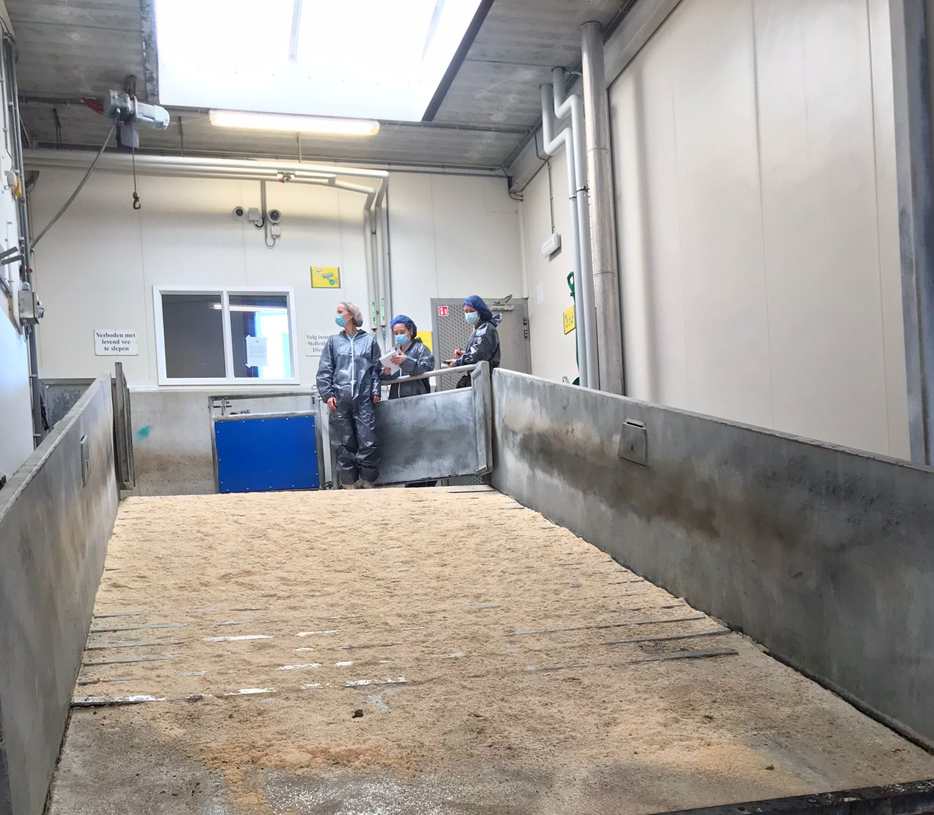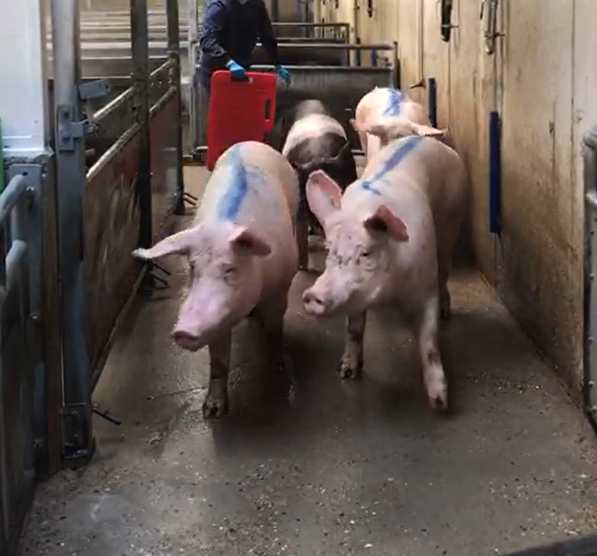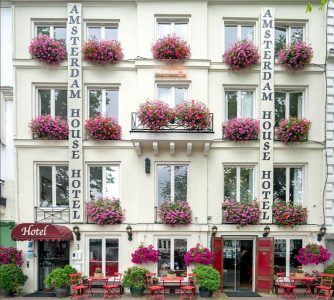Today a team visited Westfort slaughterhouse in Gorinchem. This plant slaughters culled adult sows and boars, that were used for breeding. We were told that we are always welcome to visit and even just show up. This level of transparency is very positive. The employees at this plant, just like at the other Westfort plant in IJsselstein, are thoroughly trained and receive a lot of guidance on how to handle pigs correctly and calmly. Not only are electric prods forbidden here, but ALL guiding instruments that make noise or can be used to hit, such a paddles. The only instruments permitted are plastic boards and plastic bags (imitating bird of prey) to herd the pigs forward.
The people working in the stall indeed worked calmly and smartly with the pigs There was a very kind woman from the NVWA present checking on the condition of the pigs. She was very welcoming and respectful also to us. One of the sows in the suspect-pen could not walk on all 4 legs, and it was decided that she would be stunned and slaughtered on the spot where she was, and not have to walk through the entire plant with the others. Unfortunately some of the suspect-pigs (onthouders in Dutch) have to wait 8 hours in the suspect pen as Westfort Gorinchem does not slaughter the suspect pigs before each break, as some other plants do, but rather waits until the very end of the day. These pigs especially, who are legally fit but not always feeling so well, are best to be slaughtered quickly rather than left waiting so long.
The majority of the pens in the lairage were not overcrowded. The boars were kept individually so there was no fighting, and the sows had room to walk around and lie down. One pen was more crowded than the others, where sows had little room to choose to lie down undisturbed.
Quite a number of sows had large shoulder wounds from lying down too much on hard surfaces in the farrowing crates, which are still used on conventional sow units. The unloading ramp was coated with anti-slip material and on top they had also placed a thick layer woodchips. When the bottom level of a pig truck was being unloaded, the ramp angle was 15.3 degrees. This is within the legal range, but still quite steep. However the efforts made to keep it anti-slip and the fact that no one was screaming or rattling loud paddles behind the pigs to rush them out, meant the sows and boars could walk out of the trucks calmly at their own pace, keeping fear and risk of injury very low.
We do not have any concerns about the human handling of the sows and boars at this plant, the people are very aware of pig behaviour and correct and calm with the animals, but we are concerned about the stunning. Here the sows and boars are stunned with CO2. Inhaling CO2 is painful and highly stressful as the pigs feel like they are suffocating and it takes about 30 seconds to adequately render large adult sows and boars unconscious. As well, the CO2 system at this plant was designed for “fattening” pigs, which are much shorter than culled breeding sows and boars. Thus the door frame from the raceway into the CO2 container was too low. Some sows and boars were taller, especially when one sat down or jumped onto another animal. This posed the serious risk of a head being pressed on, or even squished, by the automatic door, which pushes the group of animals into the CO2 container. There are sensors to warn the employee of weight resistance, so that he can press a button quickly to stop the automatic door (which he fortunate did) but often by then the sow or boar stuck with her or his head between the door and the entrance was already in panic. It is necessary that this risk factor, and cause of panic, be remedied. Especially because an animal in panic takes even longer to lose consciousness by CO2. They are thinking of ways to modify this. We encouraged them also to consider other ideas to make entering the CO2 container more appealing, so the pigs don’t hesitate or need to be pushed so much. Ideas such as stronger lighting, the illusion of an open end, apple odour, same colour floor as the raceway etc.
We also suggested that they consider keeping an area available in their lairage where very large sows and boars could be routinely slaughtered by manual electric stunning on the spot to avoid that they too have to enter such a low CO2 container entrance. We think this is also a good idea for pigs coming from the very high-welfare concepts. Electric stunning, when done well and calmly, in a group pen, causes immediate unconsciousness, without fear or pain. For pigs coming from innovative concepts guaranteeing low stress and high welfare, is this type of slaughter more ideal than a CO2 system. The gates in the lairage also were heavy and created abrupt loud noise.
Westfort wants to invest in a much better entrance into the CO2 container and silent, light-weight lairage gates, but first needs to increase its capacity to make it cost-effective. Right now the vast majority of culled breeding sows and boars from the Netherlands are being exported to Germany and Belgium as costs are much cheaper there. But for animal welfare reasons it would it be better to slaughter these animals close by, in the Netherlands. We hope therefore that Westfort Gorinchem will get permission to be open 5 days a week, as opposed just 2 as now, so that animals do not have to be transport far away, and so Westfort has the turn-around to quickly change the design of the entrance to the CO2 container and the gates in the lairage.
We would like to thank Westfort for their time and transparency, and for confirming that we are always welcome, even unannounced. We would like to acknowledge the animal welfare officers and handlers for taking animal-welfare seriously and being calm and confident with the animals.



